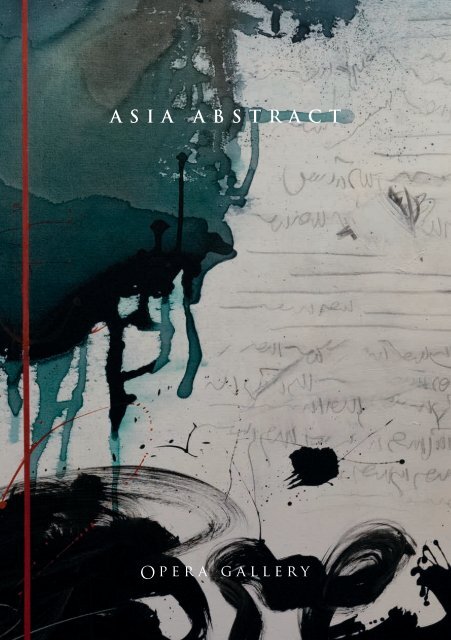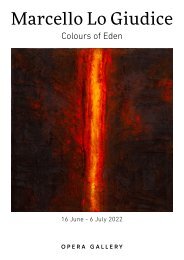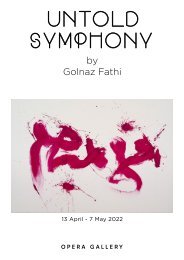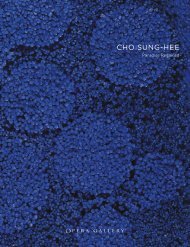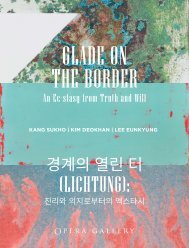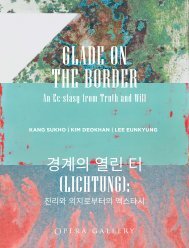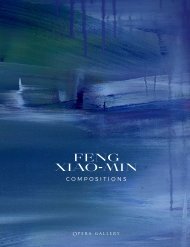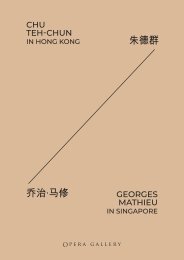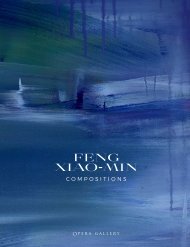Opera Gallery Hong Kong Asia Abstract
You also want an ePaper? Increase the reach of your titles
YUMPU automatically turns print PDFs into web optimized ePapers that Google loves.
ASIA ABSTRACT<br />
1
ASIA ABSTRACT<br />
28 september - 31 october 2018<br />
2 3
PREFACE<br />
<strong>Opera</strong> <strong>Gallery</strong> <strong>Hong</strong> <strong>Kong</strong> is thrilled to present a new collective exhibition that<br />
celebrates the history and heritage of <strong>Asia</strong>n art, reflecting each artists’ state of mind,<br />
addressing the themes of national identity, nature and humanity.<br />
Through abstract art in <strong>Asia</strong>, the exhibition will launch a dialogue that connects the<br />
past and present, traditional and modern designs, as well as Eastern and Western<br />
influences. Ancient Middle Eastern calligraphy, traditional Chinese ink wash painting,<br />
Korean scroll painting and paper-making, all of which are present in this show, were<br />
created through time-honoured practices of traditional <strong>Asia</strong>n art.<br />
‘<strong>Asia</strong> <strong>Abstract</strong>’ will boast a collection that fuses traditional methods with modern<br />
skills. Moving beyond language, abstract art is used for expressing the self, originality<br />
and creative impulses, providing contemplative space for expression that does not<br />
rely on language or translation.<br />
Gilles Dyan<br />
Chairman and Founder, <strong>Opera</strong> <strong>Gallery</strong> Group<br />
Sharlane Foo<br />
Director, <strong>Opera</strong> <strong>Gallery</strong> <strong>Hong</strong> <strong>Kong</strong><br />
前 言<br />
<strong>Opera</strong> <strong>Gallery</strong> 為 您 呈 現 的 新 展 覽 將 展 示 亞 洲 藝 術 的 歷 史 和 傳 統 , 反 映 每 位 藝 術 家 的<br />
思 想 , 其 中 涵 蓋 民 族 認 同 感 , 自 然 和 人 性 等 主 題 。<br />
通 過 這 場 關 於 亞 洲 抽 象 藝 術 的 展 覽 , 我 們 將 展 開 一 段 過 去 和 現 在 , 傳 統 和 當 代 , 以 及<br />
東 西 方 影 響 間 的 對 話 。<br />
古 代 中 東 書 法 、 中 國 傳 統 水 墨 畫 、 韓 國 捲 軸 畫 與 造 紙 術 , 每 件 藝 術 品 的 創 作 都 使 用 了<br />
經 久 不 衰 的 傳 統 亞 洲 藝 術 技 巧 , 亦 反 映 出 藝 術 家 多 元 化 的 文 化 背 景 和 經 歷 。<br />
‘ 亞 洲 抽 象 ’ 將 展 覽 出 一 系 列 融 合 傳 統 和 現 代 技 巧 的 作 品 。 抽 象 藝 術 用 於 表 達 自 我 ,<br />
它 超 越 語 言 , 其 原 創 性 和 創 造 靈 感 不 須 依 賴 於 翻 譯 與 語 言 , 這 種 表 達 方 式 為 人 們 提 供<br />
了 沉 思 的 空 間 。<br />
Gilles Dyan<br />
<strong>Opera</strong> <strong>Gallery</strong> 集 團 創 始 人 及 主 席<br />
Sharlane Foo 符 莎 玲<br />
<strong>Opera</strong> <strong>Gallery</strong> 香 港 總 經 理<br />
Detail of Chu Teh-Chun, Untitled, 1995, p.7<br />
4 5
Zao Wou-Ki (Chinese - French, 1920 - 2013)<br />
Untitled, 2003<br />
Signed and dated on the lower right<br />
Chinese ink on paper laid down on paper<br />
117.6 x 97.9 cm - 46.3 x 38.2 in<br />
Provenance<br />
Marlborough <strong>Gallery</strong>, Madrid<br />
Private collection, Paris<br />
Artcurial, Paris, 3 June 2014, lot 76<br />
Private collection<br />
Exhibited<br />
Madrid, Arco, Marlborough <strong>Gallery</strong>, 2006<br />
Literature<br />
This work will be included in the forthcoming Catalogue raisonné currently<br />
being prepared by Françoise Marquet, assisted by Mr. Yann Hendgen<br />
6 7
Chu Teh-Chun (Chinese - French, 1920 - 2014)<br />
Untitled, 1995<br />
Signed and dated on the lower right<br />
Oil on canvas<br />
60 x 73 cm - 23.6 x 28.7 in<br />
Provenance<br />
Private collection, France<br />
Declerck-Beghin, 7 November 1999, lot 92<br />
Private collection, France<br />
Declerck, Douai, 26 March 2006, lot 174<br />
Private collection, France<br />
Literature<br />
This work will be included in the forthcoming Catalogue raisonné being prepared<br />
by Ching-Chao Chu<br />
Certificate<br />
Ching-Chao Chu, the artist’s wife, has confirmed the authenticity of this work<br />
8 9
Feng Xiao-Min (Chinese - French, b. 1959)<br />
Blue Rhapsody, 2009<br />
Signed on the lower right<br />
Acrylic on paper laid down on canvas<br />
190 x 294 cm - 74.8 x 115.7 in (tryptich)<br />
Provenance<br />
Artist’s studio<br />
10 11
Kazuo Shiraga (Japanese, 1924 - 2008)<br />
Untitled, 1983<br />
Signed and dated on the lower left, signed on the reverse<br />
Watercolour on paper<br />
24 x 31.5 cm - 9.4 x 12.4 in<br />
Provenance<br />
Private collection<br />
Certificate<br />
The Japan Art Dealers’ Association has confirmed the authenticity of this work<br />
12 13
Bahk Seon Ghi (Korean, b. 1966)<br />
An Aggregate 201103, 2011<br />
Charcoal, nylon threads and stone<br />
270 x 45 x 45 cm - 106.3 x 17.7 x 17.7 in<br />
Provenance<br />
Artist’s studio<br />
14 15
Kim Chang-Young (Korean, b. 1957)<br />
Shin Gun Woo (Korean, b. 1978)<br />
Sand Play 2010 (1011 - R), 2010<br />
Sand and oil on canvas<br />
77 x 102 cm - 30.3 x 40.2 in<br />
Golden, 2017<br />
Signed, dated and titled on the reverse<br />
Mixed media on aluminium<br />
60 x 80 cm - 23.6 x 31.5 in<br />
Provenance<br />
Artist’s studio<br />
Provenance<br />
Artist’s studio<br />
16 17
Suh Jeong- Min (Korean, b. 1962)<br />
Om Mee Ai (Korean, b. 1969)<br />
Absence of the Worldly Desire 23, 2017<br />
Signed and dated on the lower right<br />
Korean paper on wooden board<br />
140 x 140 cm - 55.1 x 55.1 in<br />
N-COP92, 2018<br />
Oil on canvas<br />
92 x 92 cm - 36.2 x 36.2 in<br />
Provenance<br />
Artist’s studio<br />
Provenance<br />
Artist’s studio<br />
18 19
Golnaz Fathi (Iranian, b. 1972)<br />
Untitled, 2010<br />
Mixed media on canvas<br />
142 x 170 cm - 55.9 x 66.9 in<br />
Provenance<br />
Artist’s studio<br />
20 21
Nasrollah Afjehei (Iranian, b. 1933)<br />
Mohammad Ehsai (Iranian, b. 1939)<br />
Untitled, 2012<br />
Signed on the lower right<br />
Acrylic on canvas<br />
90 x 90 cm - 35.4 x 35.4 in<br />
Untitled, circa 2003 - 2004<br />
Signed on the lower left<br />
Car paint on cardboard<br />
70 x 70 cm - 27.6 x 27.6 in<br />
Provenance<br />
Artist’s studio<br />
Provenance<br />
Artist’s studio<br />
22 23
Mohammad Yaghoubian (Iranian, b. 1974)<br />
Untitled, 2014<br />
Signed and dated on the lower left of each panel<br />
Oil and tar on cardboard<br />
138 x 69 cm - 54.3 x 27.2 in<br />
Provenance<br />
Artist’s studio<br />
24 25
Sittiphon Lochaisong aka BOMB (Thai, b. 1991)<br />
Light and Shadow no. 03, 2014<br />
Signed and dated on the reverse<br />
Tempera powder on canvas<br />
200 x 150 cm - 78.7 x 59.1 in<br />
Provenance<br />
Artist’s studio<br />
26 27
BIOGRAPHIES<br />
Zao Wou-Ki (1920, China – 2013, France)<br />
趙 無 極 (1920 年 生 於 中 國 ,2013 年 逝 於 法 國 )<br />
Chu Teh-Chun (1920, China – 2014, France)<br />
朱 德 群 (1920 年 生 於 中 國 – 2014 年 逝 於 法 國 )<br />
Zao Wou-Ki was born in Beijing to an intellectual family. Shortly later the family moved<br />
to Shanghai, where Zao spent his childhood. At a young age, Zao was already learning<br />
calligraphy from his grandfather, and his artistic talent was given full freedom to bloom.<br />
Zao graduated from the China Academy of Art in Hangzhou, where he mastered the skills<br />
of drawing, sketching, Chinese painting and western oil painting. After graduated from<br />
the academy, Zao stayed and worked as an assistant teacher. His work at this period was<br />
very much influenced and inspired by French artists such as Cézanne, Matisse and Picasso.<br />
In 1948, Zao moved to Paris.<br />
In Paris, he was warmly welcomed within the intellectual community. There he met new<br />
artist friends including Sam Francis, Hans Hartung and more. His earliest art exhibitions<br />
in France were met with praise from Miró and Picasso. Zao Wou-Ki’s poetic abstract art<br />
wakes scenic-cosmic associations. He departed for his new home in France at the precise<br />
moment when the painters of the European and American <strong>Abstract</strong> art and Expressionist<br />
schools began to flourish.<br />
In 1951 during a trip to Bern, Switzerland, Zao encountered works by Paul Klee. Impressed<br />
and inspired by the master’s art, Zao shifted from figurative painting to lyrical abstract<br />
art form. Yet, despite of all these Western influences, Zao’s work is nonetheless rooted in<br />
Chinese ink painting. As a result, his works are usually dramatic yet harmonic arrangements<br />
of vibrant colours that overlap, juxtapose or blend with each other.<br />
In 1957, Zao held an exhibition at the Galerie de France, the biggest gallery<br />
in Paris at the time, which secured his international position. His works were then<br />
exhibited in major galleries such as Tate <strong>Gallery</strong> in London and Museum of Modern Art in<br />
New York. On the <strong>Asia</strong>n side, Zao’s fame came some 20 years later in the 1970s to 80s,<br />
with exhibitions held in Japan, Singapore, <strong>Hong</strong> <strong>Kong</strong> and Taipei. In 2002, he is elected<br />
member of the French Académie des Beaux-Arts.<br />
趙 無 極 出 生 於 北 京 的 知 識 分 子 家 庭 , 不 久 之 後 移 居 上 海 。 趙 無 極 在 那 裡 度 過 了 他 的 童<br />
年 。 在 很 小 的 時 候 , 他 就 已 經 隨 祖 父 學 習 書 法 , 藝 術 才 華 得 以 自 由 地 發 揮 。 趙 無 極 畢 業<br />
於 杭 州 的 中 國 美 術 學 院 , 並 掌 握 了 繪 畫 、 素 描 、 中 國 畫 及 油 畫 的 技 巧 。 畢 業 後 , 他 留 下<br />
並 擔 任 助 理 教 師 。 這 一 時 期 他 的 作 品 受 到 了 法 國 畫 家 如 塞 尚 、 馬 蒂 斯 、 畢 加 索 等 的 極 大<br />
影 響 和 啟 發 。1948 年 , 趙 無 極 移 居 巴 黎 。<br />
趙 無 極 在 巴 黎 受 到 了 知 識 界 的 熱 烈 歡 迎 。 他 結 識 了 包 括 山 姆 • 弗 朗 西 斯 、 漢 斯 · 哈 同 等<br />
藝 術 家 。 他 在 法 國 最 早 的 藝 術 展 覽 得 到 了 米 羅 和 畢 加 索 的 讚 揚 。 趙 無 極 充 滿 詩 意 的 抽 象<br />
藝 術 喚 起 了 對 風 景 、 宇 宙 的 聯 想 。 趙 抵 達 法 國 的 時 候 , 正 是 歐 洲 和 美 國 的 抽 象 藝 術 、 表<br />
現 主 義 流 派 開 始 蓬 勃 發 展 之 時 。<br />
1951 年 於 瑞 士 伯 爾 尼 旅 行 期 間 , 趙 無 極 見 到 了 保 羅 · 克 利 的 作 品 。 其 藝 術 在 他 腦 中 留 下<br />
深 刻 印 象 及 靈 感 , 從 此 他 的 作 畫 重 心 從 具 象 繪 畫 轉 到 抒 情 式 的 抽 象 藝 術 。 然 而 , 儘 管 有<br />
這 些 西 方 影 響 , 趙 無 極 的 作 品 仍 然 植 根 於 中 國 水 墨 畫 。 因 此 , 他 的 作 品 通 常 是 色 彩 間 戲<br />
劇 化 卻 又 和 諧 的 安 排 佈 置 , 彼 此 重 疊 、 並 置 或 融 合 。<br />
1957 年 , 趙 無 極 在 當 時 巴 黎 最 大 的 畫 廊 Galerie de France 舉 辦 了 一 次 展 覽 , 從 而 確 認<br />
了 他 的 國 際 地 位 , 他 的 作 品 隨 後 在 國 際 級 展 館 展 出 , 例 如 倫 敦 泰 特 美 術 館 和 紐 約 現 代 藝<br />
術 博 物 館 。 在 亞 洲 方 面 , 趙 無 極 的 名 氣 來 得 比 在 西 方 世 界 晚 了 大 約 20 年 , 在 20 世 紀 70 年<br />
代 到 80 年 代 之 間 , 他 在 日 本 、 新 加 坡 、 香 港 和 台 北 舉 辦 了 展 覽 。 他 於 2002 年 獲 頒 法 蘭 西<br />
藝 術 院 院 士 。<br />
Chu Teh-Chun was born in 1920 in Jiangsu Province, China. In 1935 he was admitted<br />
to National Hangzhou School of Art where he studied in the Chinese painting tradition<br />
under the mentorship of Pan Tianshou and Western art under Wu Dayu, both of whom are<br />
prominent artists. Chu subsequently became a teacher in Nanking and then settled in Taipei.<br />
In 1955, he moved to and settled in Paris where he would soon exhibit his works at the<br />
“Salon des Réalités Nouvelles”, a showcase location for abstract art which was a big success<br />
in Paris at the time.<br />
Initially drawn to traditional style of Chinese painting and calligraphy, Chu Teh-Chun later<br />
explored western style of painting. His work has brought about innovation on writing<br />
between poetry and painting whereby he would become renowned for his sublime<br />
integration of traditional Chinese painting and western abstract art. His works opened a<br />
new chapter in the area of landscape art, with his ability to portray landscapes that are mixed<br />
with poetry.<br />
Nature, the oceans, the world and the cosmos all become one within his paintings with<br />
elements that overlapped and morphed in a signature style. Chu created important<br />
graphic works, including drawing, ceramics, large-scale paintings, diptychs, triptychs, and other<br />
monumental works, always inventing a personal writing style between poetry and painting.<br />
Numerous successful exhibitions were held worldwide with his works collected by<br />
prestigious museums and astute art connoisseurs. In 1987, the National Palace Museum<br />
organised a grand retrospective of his artwork and in 1997, he is elected member of the<br />
French Académie des Beaux-Arts.<br />
朱 德 群 1920 年 出 生 於 中 國 江 蘇 。1935 年 , 他 考 入 國 立 杭 州 藝 術 專 科 學 校 並 隨 當 時 的 藝<br />
術 大 家 學 藝 , 從 潘 天 壽 學 中 國 畫 , 從 吳 大 羽 學 習 西 洋 畫 。 朱 德 群 曾 在 南 京 任 教 職 , 而 後<br />
定 居 台 北 。 他 1955 年 移 居 巴 黎 , 不 久 後 便 在 當 時 巴 黎 成 功 的 抽 象 藝 術 “ 法 國 新 現 實 主 義<br />
沙 龍 ” 上 展 出 其 作 品 。 朱 德 群 起 初 以 中 國 傳 統 書 畫 風 格 開 始 創 作 , 後 來 探 索 西 洋 繪 畫 。<br />
他 的 繪 畫 方 式 創 新 了 詩 歌 與 繪 畫 結 合 的 書 寫 方 式 。 他 因 其 對 中 國 傳 統 繪 畫 與 西 方 抽 象 藝<br />
術 的 超 群 融 合 而 聞 名 。 朱 德 群 的 作 品 開 啟 了 風 景 繪 畫 的 新 篇 章 , 描 繪 出 與 詩 歌 相 混 合 的<br />
風 景 。 大 自 然 、 海 洋 、 世 界 及 宇 宙 成 一 體 , 成 為 他 畫 作 之 中 的 元 素 , 這 些 元 素 在 其 標 誌<br />
性 作 品 中 重 疊 變 形 。<br />
他 創 造 了 重 要 的 繪 畫 、 陶 瓷 、 大 型 繪 畫 、 雙 聯 畫 、 三 聯 畫 及 各 種 大 型 作 品 , 始 終 在 詩 歌<br />
與 繪 畫 之 間 書 寫 個 人 風 格 。 朱 德 群 在 世 界 各 地 都 舉 辦 過 展 覽 , 其 作 品 被 各 著 名 的 博 物 館<br />
和 鑑 賞 家 收 藏 。1987 年 , 台 北 國 立 故 宮 博 物 院 曾 舉 辦 其 大 型 回 顧 展 。 朱 德 群 於 1997 年 獲<br />
頒 法 蘭 西 藝 術 院 院 士 。<br />
Feng Xiao-Min (b. 1959, China)<br />
馮 驍 鳴 (1959 年 生 於 中 國 )<br />
Feng Xiao-Min was born in Shanghai, China, in 1959. Feng’s passion for art was clear from<br />
a very young age. After fine arts studies in China, he moved to France in 1988 and enrolled<br />
at the École nationale supérieure des beaux-arts in Paris. He was later invited to teach at<br />
the same prestigious institution. His artworks show a mastery of colours and capacity for<br />
manipulating brushstrokes with a graceful and powerful poetic spirit, akin to the works of<br />
Chinese masters Zao Wou-Ki and Chu Teh-Chun, with whom he worked closely to perfect<br />
28 29
his art. Feng has also published a number of books on painting and calligraphy and many of<br />
his works now illustrating the pages of French school manuals.<br />
His works are collected and presented in various private and public collections, including<br />
galleries, museums and foundations, in France and abroad. The artist frequently exhibits at<br />
international art fairs and biennales and was commissioned to produce a work for the 2017<br />
BRICS summit.<br />
馮 驍 鳴 1959 年 出 生 於 中 國 上 海 。 他 自 幼 就 已 奠 定 對 藝 術 的 熱 情 。 在 中 國 進 行 美 術 學 習<br />
後 , 他 於 1988 年 移 居 法 國 並 入 讀 巴 黎 國 立 高 等 美 術 學 院 , 隨 後 獲 邀 留 校 任 教 。 他 的 藝 術<br />
作 品 表 現 出 對 色 彩 及 筆 觸 運 用 的 精 熟 掌 握 , 具 有 優 雅 而 強 大 的 詩 意 精 神 , 近 似 於 與 其 密<br />
切 合 作 的 中 國 藝 術 大 師 趙 無 極 與 朱 德 群 的 風 格 。 馮 驍 鳴 還 出 版 了 許 多 關 於 書 畫 的 書 籍 。<br />
他 的 許 多 作 品 現 已 都 出 現 在 法 國 的 課 本 頁 面 中 。 他 的 作 品 在 法 國 和 全 世 界 被 不 同 的 私 人<br />
及 公 共 機 構 列 入 收 藏 並 展 示 , 其 中 包 括 畫 廊 、 博 物 館 及 基 金 會 等 。 他 經 常 參 加 國 際 藝 術<br />
博 覽 會 和 雙 年 展 , 並 受 委 託 為 2017 年 金 磚 國 家 峰 會 創 作 一 幅 特 約 作 品 。<br />
Kazuo Shiraga (1924-2008, Japan)<br />
白 髮 一 雄 (1924 – 2008 年 , 日 本 )<br />
Kazuo Shiraga was a Japanese painter and performance artist born in Amagasaki,<br />
near Kyoto. In 1948, the artist graduated from the Kyoto City Specialist School<br />
of Arts (now the Kyoto City University of Arts), where he learnt traditional<br />
Japanese painting. However, the artist was more attracted to the Western<br />
artistic style. In 1952, he co-established the Zero Group with other artists including<br />
Akira Kanayama and Atsuko Tanaka. The Group was renowned for its belief that works<br />
of art are created from nothing. In 1959, the Group joined a wider artistic movement:<br />
the Gutai Art Association, which encouraged detachment from social involvement and<br />
embraced pure abstraction.<br />
Shiraga echoed the belief of the movement by the way he created his works.<br />
Inspired by the American artist Jackson Pollock, Shiraga applied significant amount of oil paint<br />
to large surfaces such as paper sheets or canvas on the floor, then he would use a rope<br />
that hangs from the ceiling and swings on top of the picture plane, allowing only his feet<br />
to touch the paint. Through the swinging movement, at times choreographed and at times<br />
spontaneous, a dynamic style unique to the artist is formulated.<br />
Throughout and after his long career, Shiraga’s works has been exhibited at many<br />
venues around the world, such as the 2009 Venice Biennale, the Museum of<br />
Contemporary Art in Los Angeles and the Solomon R. Guggenheim Museum in New York.<br />
日 本 畫 家 、 表 演 藝 術 家 白 髮 一 雄 出 生 於 京 都 附 近 的 尼 崎 市 。 他 1948 年 畢 業 於 京 都 市<br />
立 美 術 專 門 學 校 ( 現 京 都 市 立 藝 術 大 學 ) 日 本 傳 統 繪 畫 專 業 , 可 他 更 偏 好 西 方 藝 術<br />
風 格 。1952 年 , 他 與 金 山 明 、 田 中 敦 子 共 同 創 立 藝 術 團 體 「0 會 」, 認 為 藝 術 從 無 創<br />
造 。1959 年 ,「0 會 」 併 入 「 具 體 藝 術 協 會 」, 志 在 鼓 勵 藝 術 創 作 脫 離 社 會 參 與 , 擁 抱<br />
純 粹 的 抽 象 。<br />
白 髮 一 雄 以 其 創 作 方 式 實 踐 了 此 藝 術 運 動 的 信 念 。 受 美 國 藝 術 家 傑 克 遜 · 波 洛 克 的 啟<br />
發 , 白 髮 一 雄 將 大 量 油 畫 顏 料 大 面 積 地 塗 在 平 放 在 地 上 的 紙 張 或 畫 布 上 , 然 後 靠 抓 住 一<br />
根 掛 在 天 花 板 上 的 繩 子 在 畫 面 上 擺 動 , 只 有 雙 腳 接 觸 顏 料 。 通 過 這 樣 時 而 編 排 時 而 自 發<br />
的 擺 動 , 藝 術 家 創 造 出 了 一 種 獨 特 的 行 為 風 格 。<br />
在 他 漫 長 的 創 作 生 涯 中 , 其 作 品 已 在 世 界 各 地 許 多 地 方 展 出 , 如 2009 年 威 尼 斯 雙 年 展 、<br />
洛 杉 磯 當 代 藝 術 博 物 館 和 紐 約 古 根 海 姆 美 術 館 。<br />
Bahk Seon Ghi (b. 1966, South Korea)<br />
朴 善 基 (1966 年 生 於 韓 國 )<br />
Bahk Seon Ghi is a South Korean artist born in 1966. He lives and works in Kyeongki-do.<br />
Bahk has studied at the Chung-Ang University in Seoul, the Accademia di Belle Arti<br />
Brera in Milan and the Barnet and Southgate College in London. Known for exploring<br />
the relationship between nature and humanity with his distinct charcoal installations,<br />
Bahk Seon Ghi creates delicate structures by repurposing natural resources, charcoal in<br />
particular, and suspending them with transparent nylon threads. He was awarded the<br />
Kim Chong Yung Sculpture Award in 2006.<br />
朴 善 基 是 一 位 出 生 於 1966 年 的 韓 國 藝 術 家 , 他 現 生 活 及 工 作 於 韓 國 京 畿 道 。 他 曾 在 首 爾<br />
中 央 大 學 、 米 蘭 布 雷 拉 美 術 學 院 、 倫 敦 巴 內 特 · 索 斯 蓋 特 學 院 學 習 。 朴 善 基 以 其 獨 特 的<br />
木 炭 裝 置 作 品 探 索 自 然 與 人 性 之 間 的 關 係 而 聞 名 。 藝 術 家 通 過 重 新 利 用 自 然 資 源 , 尤 其<br />
是 木 炭 , 並 用 透 明 尼 龍 線 懸 掛 它 們 來 創 作 精 巧 的 裝 置 結 構 。 朴 善 基 於 2006 年 獲 金 鐘 瑛 雕<br />
塑 獎 。<br />
Kim Chang-Young (b. 1957, South Korea)<br />
金 昌 永 (1957 年 生 於 韓 國 )<br />
Born in 1957 in Daegu, South Korea, Kim Chang-Young has been living in Japan since 1982.<br />
In 1984 and 1986, he graduated from the Sokei Academy of Fine Art and the Tokyo<br />
University of the Arts (both in Japan) respectively.<br />
Considered one of the most reputed Korean contemporary artists today, Kim specialises<br />
in re-creating beach scenes, complete with the remnants of human interaction.<br />
The artist uses mixed media, including real sand, to create his impressions of sandy<br />
coasts. It is common to find his paintings filled with human footprints, wind<br />
dunes and other natural formations. As part of a creative process to preserve the<br />
elements of faded memories, Kim solidifies moments which might otherwise be<br />
washed away and sees this as a method of expressing how humans and nature can co-exist<br />
in harmony. He gives us clues to understand his work: “Perhaps my works remind you of<br />
photographs of a sandy beach having been explored; yet they are oil paintings. If you<br />
study them, I think you will understand their meaning. Eventually, the footprints will be<br />
washed away by the waves. There are no people present, but just as the footprints are proof<br />
of a human presence, I like to think I’m recording the memory of their nearness”.<br />
Kim Chang-Young has participated in several exhibitions in Japan, Korea and Germany; his<br />
genius has captivated collectors from all over the world.<br />
金 昌 永 1957 年 出 生 於 韓 國 大 邱 , 並 於 1982 年 移 居 日 本 。 他 1984 年 畢 業 於 東 京 創 形 美 術<br />
學 校 ,1986 年 畢 業 於 東 京 藝 術 大 學 。<br />
金 昌 永 被 認 為 是 當 今 最 知 名 的 韓 國 當 代 藝 術 家 之 一 。 他 的 創 作 專 注 於 海 灘 景 象 的 再 現 ,<br />
人 類 活 動 的 殘 景 。 藝 術 家 使 用 混 合 媒 材 , 包 括 真 正 的 沙 子 , 來 再 現 他 對 沙 灘 的 印 象 。 在<br />
他 的 畫 作 中 經 常 可 以 發 現 人 的 腳 印 、 風 中 形 成 的 沙 丘 以 及 其 他 自 然 形 態 。 金 昌 永 凝 固 會<br />
被 沖 走 的 時 刻 , 為 其 創 作 過 程 的 一 部 分 , 以 保 存 這 些 逐 漸 褪 色 的 記 憶 。 他 將 其 視 為 表 達<br />
人 與 自 然 如 何 和 諧 共 存 的 一 種 方 式 。 他 向 我 們 提 供 了 理 解 其 作 品 的 線 索 :“ 也 許 我 的 作<br />
品 讓 你 想 起 那 被 踏 足 的 沙 灘 。 但 它 們 是 油 畫 。 如 果 你 研 究 它 們 , 我 想 你 會 理 解 它 們 的 含<br />
意 。 最 終 , 腳 印 會 被 海 浪 沖 走 , 沒 有 人 在 場 。 但 正 如 腳 印 是 人 類 在 場 的 證 據 , 我 認 為 我<br />
是 在 記 錄 他 們 曾 親 近 的 記 憶 ”。 金 昌 永 參 加 過 日 本 、 韓 國 和 德 國 的 眾 多 展 覽 , 他 的 天 賦<br />
吸 引 了 來 自 世 界 各 地 的 收 藏 家 。<br />
30 31
Shin Gun Woo (b. 1978, South Korea)<br />
申 建 宇 (1978 年 生 於 韓 國 )<br />
Shin Gun Woo is a Korean artist born in 1978. Between 1997 and 2006, Shin finished his<br />
Bachelor and Master degrees in Fine Arts specialised in sculpture at the Seoul National<br />
University. After, he moved to London to further his studies and acquired a second Master<br />
degree in sculpture at the Slade School of Fine Art, UCL. Since then, the artist has been<br />
working and actively participating in exhibitions both in London, UK and Seoul, Korea.<br />
Shin’s works are termed by the artist as “mental landscapes”, they are based on both<br />
specific circumstances in everyday life, as well as unconscious situations such as memories<br />
and dreams. Through these works and the process of making them, the artist’s senses that<br />
are numbed by daily routines are awakened. In these landscapes, Shin’s artistic imaginations<br />
are given realistic subject matters.<br />
The artist expresses his conscious and unconscious emotions through two major pictorial<br />
appearances. One has more narrative and the influence of Renaissance masters, such as<br />
Hieronymus Bosch and Pieter Bruegel is more apparent. The other is more biased towards<br />
abstract art, in which the picture plane is flooded with vibrant colours with subject matters<br />
floating freely in space.<br />
By placing three-dimensional figures made of resin on flat boards or canvases,<br />
making the picture surface almost like a relief, as well as using special materials such as<br />
aluminium as painting board, Shin’s works constantly challenge the definitions of sculpture<br />
and painting.<br />
出 生 於 1978 年 的 申 建 宇 是 一 位 韓 國 藝 術 家 。1997 年 至 2006 年 間 , 申 建 宇 在 首 爾 大 學 先<br />
後 取 得 雕 塑 藝 術 學 士 及 碩 士 學 位 。 隨 後 , 他 移 居 英 國 倫 敦 繼 續 深 造 , 並 於 倫 敦 大 學 學 院<br />
斯 萊 德 美 術 學 院 獲 得 其 第 二 個 雕 塑 碩 士 學 位 。 從 那 時 起 , 他 一 直 在 倫 敦 和 首 爾 兩 地 工 作<br />
並 積 極 參 與 展 覽 。<br />
申 建 宇 稱 其 作 品 為 “ 心 理 景 觀 ”, 它 們 基 於 日 常 生 活 的 特 定 情 況 , 如 記 憶 和 夢 境 等 無 意<br />
識 情 境 。 經 過 這 些 作 品 的 製 作 過 程 , 藝 術 家 從 其 麻 木 的 例 行 日 常 中 覺 醒 。 在 這 些 景 觀 作<br />
品 中 , 申 建 宇 的 藝 術 想 像 力 被 賦 予 了 現 實 主 題 。<br />
他 通 過 兩 個 主 要 的 方 式 來 表 達 有 意 識 的 和 無 意 識 的 情 感 。 其 中 一 種 更 具 敘 事 性 , 耶 羅 尼<br />
米 斯 · 博 斯 和 老 彼 得 · 勃 魯 蓋 爾 等 文 藝 復 興 時 期 大 師 的 影 響 更 為 明 顯 。 另 一 種 則 更 傾 向<br />
於 抽 象 性 , 顏 色 鮮 豔 、 描 繪 的 對 象 在 畫 面 空 間 中 自 由 浮 動 。<br />
申 建 宇 的 作 品 不 斷 挑 戰 雕 塑 和 繪 畫 的 定 義 , 通 過 在 平 板 或 畫 布 上 放 置 由 樹 脂 製 成 的 三 維<br />
圖 像 使 畫 面 看 起 來 像 浮 雕 一 樣 。 他 同 時 還 使 用 鋁 等 特 殊 材 料 作 為 繪 畫 板 。<br />
Suh Jeong-Min (b. 1961, South Korea)<br />
徐 正 旻 (1961 年 生 於 韓 國 )<br />
Born in Korea in 1961, Suh Jeong- Min received his BFA from Chosun University and his<br />
MFA from Kyonggi University. He is known for his use of Hanji, traditional Korean mulberry<br />
paper, to create elegant and imposing works that are neither painting nor sculpture, yet<br />
have properties of both. His artwork employs the timeless structures of geometry while<br />
simultaneously pursuing an idiosyncratic aesthetic that combines cultural references with<br />
unusual formal techniques. Suh uses Hanji originally used for calligraphy, tightly rolled into<br />
tubes or overlaid so that they resemble thin blocks of wood, cut into small pieces by hand<br />
and fixed to the support with a rice-based glue.<br />
Suh’s works have a visual load despite the lightness of the material. Arranged in concentric<br />
circles, in rows, or set on top of each other like stacks of lumber, these paper units have<br />
a dense bodily presence. Cut horizontally, vertically or diagonally, they produce light and<br />
shade on the canvas as existing calligraphic letters form black lines on the surface. The<br />
artist said his works are the result of coincidence and inevitability. “Instead of drawing my<br />
own lines with meok (ink), I find the lines from what others already wrote”. What appears to<br />
be a severance from <strong>Asia</strong>n painting in Suh’s work is instead a continuity of the practice in a<br />
new guise. As a craft unique to Korea, Hanji is considered integral to the culture. Suh’s use<br />
of the traditional material can be seen as an acknowledgment of this craft, showing how an<br />
aspect of culture long superseded by technological changes can be transformed from the<br />
commonplace to the exceptional through an artist’s innovative methods.<br />
徐 正 旻 1961 年 出 生 於 韓 國 , 分 別 於 朝 鮮 大 學 取 得 藝 術 學 士 學 位 與 京 畿 大 學 取 得 藝 術 碩 士<br />
學 位 。 他 以 使 用 由 桑 樹 的 樹 皮 製 成 的 傳 統 韓 紙 來 創 作 而 聞 名 , 既 不 是 繪 畫 又 不 是 雕 塑 ,<br />
而 是 具 兩 者 特 性 優 雅 而 有 氣 勢 的 藝 術 品 。 他 的 作 品 採 用 了 永 恆 的 幾 何 結 構 , 同 時 追 求 一<br />
種 特 殊 的 美 學 , 將 文 化 參 照 與 不 同 尋 常 的 形 式 技 巧 相 結 合 。 藝 術 家 使 用 最 初 用 於 書 法<br />
的 韓 紙 , 將 它 們 緊 緊 地 捲 成 管 狀 或 重 重 層 疊 覆 蓋 , 像 薄 木 塊 一 樣 , 然 後 用 手 把 它 們 切 成<br />
小 塊 並 用 米 膠 黏 在 支 撐 物 上 。 儘 管 材 料 很 輕 , 但 徐 正 旻 的 作 品 在 視 覺 上 讓 人 感 覺 到 其 重<br />
量 。 這 些 管 狀 的 紙 以 同 心 圓 形 排 列 、 成 排 排 列 , 或 像 堆 疊 的 木 材 一 樣 被 重 疊 , 從 而 形 成<br />
密 集 的 立 體 作 品 。 由 水 平 、 垂 直 或 對 角 的 切 割 方 式 , 這 些 紙 管 在 畫 布 上 產 生 明 暗 對 比 ,<br />
就 像 是 書 法 字 形 成 的 黑 色 線 條 。 藝 術 家 説 他 的 作 品 是 巧 合 和 必 然 性 的 結 果 。“ 我 沒 有 用<br />
墨 水 繪 製 自 己 的 線 條 , 而 是 從 其 他 人 已 經 寫 過 的 內 容 中 找 到 了 這 些 線 條 。” 相 對 於 亞 洲<br />
繪 畫 , 徐 正 旻 的 作 品 實 際 上 是 一 種 新 的 形 式 的 實 踐 連 續 , 這 便 是 兩 者 之 間 的 區 別 。 作 為<br />
韓 國 獨 有 的 工 藝 , 韓 紙 被 認 為 是 其 文 化 的 一 部 分 。 藝 術 家 對 傳 統 材 料 的 運 用 可 以 看 作 是<br />
對 這 此 工 藝 的 認 同 , 另 一 方 面 , 也 顯 示 了 藝 術 家 的 創 新 方 法 , 如 何 將 長 期 被 技 術 革 新 所 取<br />
代 的 文 化 化 腐 朽 為 神 奇 。<br />
Om Mee Ai (b. 1969, South Korea)<br />
嚴 美 愛 (1969 年 生 於 韓 國 )<br />
Om Mee Ai is a Korean artist who is now practicing both in <strong>Hong</strong> <strong>Kong</strong> and in Singapore.<br />
She specialises in painting and graduated with a Master of Fine Arts (Painting) from the Open<br />
University in the UK in 2006.<br />
Om’s work often has a geometric, monochromic but improvised visual with unique colour<br />
and texture, this is created by her tirelessly repeating the actions of “taping, layering and<br />
wiping”. The repetition as well as her habit of working simultaneously means that one piece<br />
can take up to three months to complete.<br />
Om believes that art is a representation of “internal reality”, it should also nurture our spirit<br />
and mind. Because of her aim to connecting her work with the inner emotions of the viewer,<br />
her work is highly personal. Not only is the specific appearances created by varied light<br />
source and time of day, viewers are encouraged to have individual interactions with the work<br />
and the environment surrounding them.<br />
Om’s works are in the collections of the Singapore Art Museum (SAM), as well as the Mandarin<br />
Oriental Hotel in Singapore and Jakarta, Indonesia. In 2014, Om has won the 33 rd UOB<br />
Painting of the Year Competition in Singapore. She has also won in the same competition<br />
previously in the <strong>Abstract</strong> Medium category in 2003, 2006 and 2007.<br />
32 33
嚴 美 愛 是 一 位 韓 國 藝 術 家 , 她 工 作 與 生 活 於 香 港 、 新 加 坡 兩 地 。 嚴 美 愛 是 一 位 畫 家 , 她<br />
於 2006 年 在 英 國 開 放 大 學 取 得 藝 術 碩 士 學 位 ( 繪 畫 )。<br />
嚴 美 愛 的 作 品 通 常 具 有 幾 何 性 、 單 色 但 即 興 的 視 覺 效 果 , 配 合 獨 特 的 色 彩 和 紋 理 , 這 是<br />
她 孜 孜 不 倦 地 重 複 “ 貼 、 疊 、 擦 ” 三 個 動 作 而 創 造 出 來 的 。 重 複 的 動 作 加 上 她 習 慣 於 同<br />
時 創 作 幾 件 作 品 , 最 終 一 件 作 品 可 花 長 達 三 個 月 完 成 。<br />
嚴 美 愛 認 為 藝 術 是 “ 內 在 現 實 ” 的 呈 現 , 它 也 應 該 培 養 我 們 的 精 神 和 思 想 。 她 的 目 的 是 將<br />
其 作 品 與 觀 眾 的 內 心 情 感 聯 繫 起 來 , 所 以 其 作 品 非 常 個 人 化 。 不 同 的 光 源 和 時 間 使 得 作 品<br />
呈 現 出 特 定 的 效 果 , 不 僅 如 此 , 觀 眾 也 被 鼓 勵 與 其 作 品 及 周 圍 環 境 產 生 單 獨 的 互 動 。<br />
她 的 作 品 被 收 藏 於 新 加 坡 美 術 館 、 新 加 坡 文 華 東 方 酒 店 和 雅 加 達 文 華 東 方 酒 店 。2014<br />
年 , 她 參 加 新 加 坡 第 33 屆 大 華 銀 行 全 國 繪 畫 比 賽 並 勝 出 。 她 還 曾 分 別 於 2003 年 、2006<br />
年 和 2007 年 在 同 一 比 賽 的 抽 象 類 別 中 勝 出 。<br />
Golnaz Fathi (b. 1972, Iran)<br />
貢 奈 絲 · 法 蒂 (1972 年 生 於 伊 朗 )<br />
Golnaz Fathi was born in Tehran in 1972. She graduated with a BA degree in graphic<br />
design from Azad Art University in Tehran and went on to obtain a degree in calligraphy<br />
from the Calligraphy Association in Tehran in 1995. That same year she was awarded a prize<br />
for Best Female Calligrapher. Fathi spent three months at the Cité Internationale des Arts<br />
in Paris, and has participated in many exhibitions including at the Queens Library <strong>Gallery</strong> in<br />
New York in 2002, the Central Public Library in Los Angeles in 2002, the Art Museum of<br />
Southeast Texas in Beaumont in 2003, the Museum of Arts and Sciences in Florida in 2003,<br />
the Meridian International Center in Washington D.C. in 2007 and Word into Art at the<br />
British Museum in London in 2008.<br />
貢 奈 絲 · 法 蒂 1972 年 出 生 於 伊 朗 德 黑 蘭 。 她 畢 業 於 德 黑 蘭 阿 扎 德 藝 術 大 學 平 面 設 計 系 ,<br />
取 得 學 士 學 位 , 並 於 1995 年 獲 得 德 黑 蘭 書 法 協 會 書 法 學 位 。 同 年 , 她 獲 頒 最 佳 女 書 法 家<br />
獎 。 她 曾 在 巴 黎 藝 術 村 駐 地 三 個 月 , 曾 參 加 了 許 多 展 覽 , 包 括 於 紐 約 皇 后 圖 書 館 (2002<br />
年 )、 洛 杉 磯 公 共 中 央 圖 書 館 (2002 年 )、 波 蒙 特 德 克 薩 斯 東 南 藝 術 博 物 館 (2003 年 )<br />
、 佛 羅 里 達 州 藝 術 與 科 學 博 物 館 (2003 年 )、 華 盛 頓 特 區 子 午 線 國 際 中 心 (2007 年 ) 及<br />
大 英 博 物 館 (2008 年 )。<br />
Nasrollah Afjehei (b. 1933, Iran)<br />
納 斯 魯 拉 · 阿 夫 傑 (1933 年 生 於 伊 朗 )<br />
Nasrollah Afjehei is an Iranian artist born in Tehran, the capital of the country, in 1933.<br />
He studied in his homeland and received his art diploma there. From 1997 to 2004, Afjehei<br />
had been teaching at schools and universities in Tehran. The artist has been practicing for<br />
more than 27 years, specialising in Indian calligraphy.<br />
In line with other contemporaries who experiment with alternative ways of performing<br />
calligraphy, such as Mohammad Ehsai, Afjehei created his own version by playing with<br />
abstraction and planning carefully the angles taken in each piece. In this way, the originality<br />
of his unique style is preserved.<br />
His inspiration is his surroundings. The nature, especially the sea’s rhythmic and fluid<br />
movement, is apparent in his wave-like compositions. Such composition not only connects<br />
him to the kinetic art of the 1960s, which reduced landscapes into various colour planes, it<br />
is also a result of his clever manipulation of calligraphic techniques and colour palettes.<br />
The intense and emotive energy invoked by vibrant colour is the fuel that brings Afjehei’s<br />
works beyond the border of geography and creates an universal language that raw emotions<br />
stimulated within viewers themselves.<br />
納 斯 魯 拉 · 阿 夫 傑 是 一 位 伊 朗 藝 術 家 , 於 1933 年 出 生 於 首 都 德 黑 蘭 。 他 在 德 黑 蘭 學 習 並<br />
獲 得 美 術 文 憑 。1997 年 至 2004 年 間 , 阿 夫 傑 一 直 在 德 黑 蘭 任 教 。 他 專 攻 印 度 書 法 至 今 已<br />
經 27 年 。<br />
與 其 他 同 時 代 實 驗 另 類 書 法 的 藝 術 家 , 例 如 穆 罕 默 德 · 埃 赫 賽 , 阿 夫 傑 通 過 抽 象 手 法 及<br />
仔 細 規 劃 每 件 作 品 的 入 手 角 度 來 創 造 自 己 特 有 的 版 本 。 他 以 這 種 方 式 來 展 現 自 己 獨 特 的<br />
風 格 及 其 新 鮮 感 。<br />
他 的 靈 感 來 自 於 他 身 邊 的 環 境 。 大 自 然 , 尤 其 是 海 洋 的 節 奏 及 其 流 暢 的 運 動 , 在 他 波 浪<br />
般 的 構 圖 中 顯 而 易 見 。 這 種 構 圖 與 20 世 紀 60 年 代 的 將 景 觀 簡 化 為 不 同 顏 色 平 面 的 動 力 藝<br />
術 相 關 聯 , 這 也 是 他 巧 妙 操 縱 書 法 技 巧 及 色 彩 配 搭 的 結 果 。<br />
有 感 染 力 的 色 彩 所 帶 來 的 強 烈 且 充 滿 情 感 的 能 量 使 其 作 品 能 夠 超 越 地 理 界 線 , 並 創 造 了<br />
一 種 有 通 用 性 的 語 言 , 激 發 觀 眾 自 身 的 原 始 情 感 。<br />
Mohammad Ehsai (b. 1939, Iran)<br />
穆 罕 默 德 · 埃 赫 賽 (1939 年 生 於 伊 朗 )<br />
Mohammad Ehsai was born in Iran in 1939. He studied at the department of fine arts at the<br />
University of Tehran. Later, he became a calligraphy instructor at the same university.<br />
The Tehran Seyhoun Art <strong>Gallery</strong> began to exhibit his works from 1973 and he held a solo<br />
exhibition at the Paris Cyrus <strong>Gallery</strong> in 1975. One year later, he was awarded a prize at<br />
the Cagnes-sur-Mer International Painting Festival and took part in the Basel International<br />
Painting Festival from 1976 to 1978. During this period, he designed the conference hall of<br />
the Ellahiat Faculty in Iran and his works are presented as part of the permanent collections<br />
at the Museum of Contemporary Art and the Museum of Fine Arts, both in Tehran.<br />
Mohammad Ehsai lives and works in Tehran.<br />
穆 罕 默 德 · 埃 赫 賽 於 1939 年 出 生 於 伊 朗 。 他 曾 就 讀 於 德 黑 蘭 大 學 美 術 系 , 之 後 留 校 任 書<br />
法 導 師 。<br />
德 黑 蘭 Seyhoun 畫 廊 從 1973 年 開 始 展 出 他 的 作 品 。1975 年 , 巴 黎 Cyrus 畫 廊 舉 辦 其 個<br />
展 。 一 年 後 , 他 在 法 國 Cagnes-sur-Mer 國 際 繪 畫 節 上 獲 獎 , 並 於 1976 年 至 1978 年 間 參<br />
加 巴 塞 爾 國 際 畫 展 。 同 時 , 他 參 與 設 計 了 伊 朗 Ellahiat 學 院 的 會 議 廳 。 他 的 作 品 被 德 黑 蘭<br />
當 代 藝 術 博 物 館 和 德 黑 蘭 美 術 博 物 館 永 久 收 藏 並 展 出 。<br />
埃 赫 賽 目 前 生 活 及 工 作 於 伊 朗 德 黑 蘭 。<br />
Mohammad Yaghoubian (b. 1974, Iran)<br />
穆 罕 默 德 · 雅 古 比 安 (1974 年 生 於 伊 朗 )<br />
Mohammad Yaghoubian is an Iranian artist born in 1974. He is known for his paintings of<br />
interwoven calligraphy of the original Persian alphabet. Drawing from the principles of<br />
Naghashi Khat, a contemporary practice of painting-calligraphy, Yaghoubian’s work<br />
expresses an appreciation for Farsi literature and the state of mind that applies colour<br />
and painting to poetry.<br />
34 35
出 生 於 1974 年 的 穆 罕 默 德 · 雅 古 比 安 是 一 位 伊 朗 藝 術 家 。 他 以 原 始 波 斯 字 母 構 成 的 交 織<br />
書 法 繪 畫 作 品 而 聞 名 。 以 Naghashi Khat( 一 種 繪 畫 和 書 法 結 合 的 當 代 藝 術 創 作 實 踐 )<br />
的 原 則 為 根 據 , 雅 古 比 安 的 作 品 表 達 了 其 對 波 斯 文 學 的 欣 賞 以 及 將 色 彩 和 繪 畫 應 用 於 詩<br />
歌 的 心 態 。<br />
Sittiphon Lochaisong, aka BOMB (b. 1991, Thailand)<br />
BOMB 西 迪 蓬 · 洛 差 頌 (1991 年 生 於 泰 国 )<br />
Sittiphon Lochaisong, also known as Bomb, is an abstract artist born in Maha Sarakham,<br />
Thailand, in 1991. He graduated from the University of Silpakorn, Bangkok, Thailand, with<br />
a BA and a MA in visual arts. His art is a subtle combination of traditional Thai influences.<br />
Clear and blurred points are joined and assembled. Points, figures and symbols meet with<br />
imagination and sensation. The contrasting roughness and delicacy reflect a complicated<br />
mind which embraces extremes: good and bad, birth and death without a cause. They show<br />
moral principles, which motivate the viewer to realise one’s state of mind: the consciousness<br />
perceives the unstoppable movement of abstract nature, causing the mind to concentrate,<br />
understand the truth, and sense the natural good and bad.<br />
西 迪 蓬 · 洛 差 頌 ( 外 號 Bomb),1991 年 出 生 於 泰 國 瑪 哈 沙 拉 堪 府 , 是 一 位 抽 象 藝 術<br />
家 。 他 畢 業 於 泰 國 藝 術 大 學 , 並 取 得 視 覺 藝 術 專 業 的 學 士 和 碩 士 學 位 。 洛 差 頌 的 風 格 受<br />
各 種 傳 統 泰 國 文 化 的 影 響 。 在 他 的 作 品 中 , 清 晰 和 模 糊 的 點 被 組 合 到 一 起 , 點 、 物 及 符<br />
號 都 充 滿 了 想 像 力 及 感 覺 。 粗 糙 和 精 細 間 的 結 合 反 映 了 一 種 包 含 兩 個 極 端 的 複 雜 的 思<br />
想 : 善 與 惡 , 無 緣 無 端 的 生 和 死 。 它 們 表 現 出 道 德 的 原 則 , 激 發 觀 眾 去 認 識 及 感 悟 其 思<br />
想 狀 態 : 以 意 識 感 知 抽 象 自 然 不 可 停 止 的 運 動 , 使 思 想 得 以 集 中 , 理 解 真 理 , 了 解 自 然<br />
的 好 與 壞 。<br />
Detail of Shin Gun Woo, Golden, 2017, p.15<br />
36 37
Published by <strong>Opera</strong> <strong>Gallery</strong> to coincide with the exhibition <strong>Asia</strong> <strong>Abstract</strong>, 28 September<br />
to 31 October 2018, <strong>Hong</strong> <strong>Kong</strong>.<br />
All rights reserved. Except for the purposes of review, no part of this book may be<br />
reproduced, stored in a retrieval system, or transmitted, in any form or by any means,<br />
electronic, mechanical, photocopying, recording or otherwise, without the prior<br />
permission of the publishers.<br />
Cover: Detail, Golnaz Fathi, Untitled, 2010<br />
Coordinator: Lou Mo<br />
Designer: Laurent Aidenbaum<br />
Printer: Green Pagoda Printing<br />
W Place, 52 Wyndham Street, Central, <strong>Hong</strong> <strong>Kong</strong><br />
+ 852 2810 1208 | hkg@operagallery.com operagallery.com<br />
38


